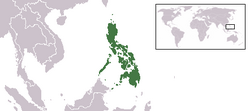Commonwealth of the Philippines
|
|||||||||||||||||||||||||||||||||||||||||||||||||||||||||||
The Commonwealth of the Philippines (Spanish: Mancomunidad de Filipinas), also known simply as the Commonwealth and as the Philippine Commonwealth,[2][3] was the political designation of the Philippines from 1935 to 1946 when the country was a commonwealth with the United States. Before 1935, the Philippines was an insular area with non-commonwealth status, and before that, it had been a U.S. territory.[4]
The creation of the Commonwealth was envisioned under the Philippine Independence Act, popularly known as the Tydings-McDuffie Act as a ten-year transitional government in preparation for full Philippine independence and sovereignty,[5][6] which was promised through the Philippine Autonomy Act or Jones Law.[7][8] The Commonwealth was officially inaugurated in November 15, 1935.[1] During this period, the Commonwealth exercised semi-independence in its territories.[2][9]
It marked the end of the colonial eras as well as the transition of the nomenclature of the Philippines from the plural "Las Islas Filipinas" and "Philippine Islands" of the Spanish and American colonial periods, to the singular, "Philippines".
Contents |
Structure
The Commonwealth had its own constitution, which remained effective until 1973,[10] and was self-governing[11] although foreign policy and military affairs would be under the responsibility of the United States, and certain legislation required the approval of the American President.[12]
It featured a very strong executive, a unicameral National Assembly,[13][14] and a Supreme Court,[15] all composed entirely of Filipinos, as well as an elected Resident Commissioner to the United States House of Representatives (as Puerto Rico does today). An American High Commissioner and an American Military Advisor,[16] were also present in the government while a Field Marshall was in charge of the Philippine Army.
In 1939-40, after an amendment in the Constitution, a bicameral Congress,[17] consisting of a Senate,[17] and of a House of Representatives,[17] was restored replacing the National Assembly.[17]
History
Creation
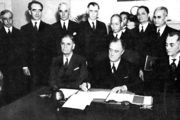
In December 1932, the United States Congress passed the Hare-Hawes-Cutting Act with the premise of granting Filipinos independence. Provisions of the bill included reserving several military and naval bases for the United States, as well as imposing tariffs and quotas on Philippine exports.[4][18] It was vetoed by President Herbert Hoover but the American Congress overrode his veto in 1933 and passed the bill.[19] The bill, however, was opposed by the then Philippine Senate President Manuel L. Quezon and was also rejected by the Philippine Senate.[12]
This led to the creation and passing of a new bill known as Tydings-McDuffie Act[20], which allowed the establishment of the Commonwealth of the Philippines with a ten-year period of peaceful transition to full independence.[4]
A Constitutional Convention was convened in Manila on July 30, 1934. On February 8, 1935, the 1935 Constitution of the Republic of the Philippines was approved by the convention by a vote of 177 to 1. The constitution was approved by President Franklin D. Roosevelt on March 23, 1935 and ratified by popular vote on May 14, 1935.[21][22]
In October 1935, presidential elections were held. Candidates included former president Emilio Aguinaldo, the Iglesia Filipina Indepediente leader Gregorio Aglipay, and others. Manuel L. Quezon and Sergio Osmeña of the Nacionalista Party were proclaimed the winners, winning the seats of president and vice-president, respectively.[4]
The Commonwealth Government was inaugurated on the morning of November 15, 1935, in ceremonies held on the steps of the Legislative Building in Manila. The event was attended by a crowd of around 300,000 people.[1]
Pre-War
The new government embarked on ambitious nation-building policies in preparation for economic and political independence.[4] These included national defense (such as the National Defense Act of 1935, which organized a conscription for service in the country), greater control over the economy, the perfection of democratic institutions, reforms in education, improvement of transport, the promotion of local capital, industrialization, and the colonization of Mindanao.
However, uncertainties, especially in the diplomatic and military situation in Southeast Asia, in the level of U.S. commitment to the future Republic of the Philippines, and in the economy due to the Great Depression, proved to be major problems. The situation was further complicated by the presence of agrarian unrest, and of power struggles between Osmeña and Quezon,[4] especially after Quezon was permitted to be re-elected after one six-year term.
A proper evaluation of the policies' effectiveness or failure is difficult due to Japanese invasion and occupation during World War II.
World War II
Japan launched a surprise attack on the Philippines on December 8, 1941. The Commonwealth government drafted the Philippine Army into the U.S. Army Forces Far East, which would resist Japanese occupation. Manila was declared an open city to prevent its destruction[23], and it was occupied by the Japanese on January 2, 1942.[24] Meanwhile, battles against the Japanese continued on the Bataan Peninsula, Corregidor, and Leyte until the final surrender of United States-Philippine forces on May 1942.[25]
Quezon and Osmeña were escorted by troops from Manila to Corregidor, and later they left for Australia and then the United States. There they set up a government in exile,[26] which participated in the Pacific War Council as well as the Declaration by United Nations. During this exile, Quezon became ill with tuberculosis, and later he died of it. Osmeña replaced him as the president.
Meanwhile, the Japanese military organized a new government in the Philippines known as the Second Philippine Republic, which was headed by president José P. Laurel. This government ended up being very unpopular.[27]
The resistance to the Japanese occupation continued in the Philippines. This included the Hukbalahap ("People's Army Against the Japanese"), which consisted of 30,000 armed people and controlled much of Central Luzon.[27] Remnants of the Philippine Army also fought the Japanese through guerrilla warfare, and it was successful, since all but twelve of the forty-eight provinces were liberated.[27]
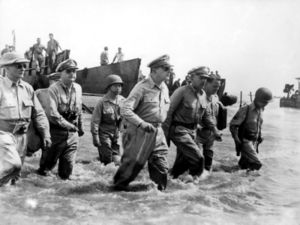
The American General Douglas MacArthur's army landed on Leyte on 20 October 1944, and they were all welcomed as liberators,[4] along with Philippine Commonwealth troops when other amphibious landings soon followed. Fighting continued in remote corners of the Philippines until Japan's surrender in August 1945, which was signed on 2 September in Tokyo Bay. Estimates for Filipino casualties reached one million, and Manila was extensively damaged when certain Japanese forces refused to vacate the city (against their orders from the Japanese High Command).[27]
After the War in the Philippines, the Commonwealth was restored, and a one-year transitional period in preparation for independence began. Elections followed in April 1946 with Manuel Roxas winning as the first president of the independent Republic of the Philippines and Elpidio Quirino winning as vice-president. In spite of the years of Japanese occupation, the Philippines became independent exactly as scheduled a decade before, on July 4, 1946.
Independence
The Commonwealth ended when the United States recognized Philippine independence on July 4, 1946, as scheduled.[16][28] However, the economy remained dependent to the U.S..[29] This was due to the Bell Trade Act, otherwise known as the Philippine Trade Act, which was a precondition for receiving war rehabilitation grants from the United States.[30]
Policies
Uprisings and agrarian reform
At the time, tenant farmers held grievances often rooted to debt caused by the sharecropping system, as well as by the dramatic increase in population, which added economic pressure to the tenant farmers' families.[31] As a result, an agrarian reform program was initiated by the Commonwealth. However, success of the program was hampered by ongoing clashes between tenants and landowners.
An example of these clashes includes one initiated by Benigno Ramos through his Sakdalista movement,[32] which advocated tax reductions, land reforms, the breakup of the large estates or haciendas, and the severing of American ties. The uprising, which occurred in Central Luzon on May, 1935, claimed about a hundred lives.
National language
Due to the diverse number Philippine languages, a program for the "development and adoption of a common national language based on the existing native dialects" was drafted in the 1935 Philippine constitution.[33] The Commonwealth created a Surian ng Wikang Pambansa (National Language Institute), which was composed of Quezon and six other members from various ethnic groups. A deliberation was held and Tagalog[33] (due to its extensive literary tradition) was selected as the basis for the "national language" to be called "Pilipino".
In 1940, the Commonwealth authorized the creation of a dictionary and grammar book for the language. On the same year, Commonwealth Act 570 was passed, allowing Pilipino to become an official language upon independence.[33]
Economy

The cash economy of the Commonwealth was mostly agriculture-based. Products included abaca, coconuts and coconut oil, sugar, and timber.[34] Numerous other crops and livestock were grown for local consumption by the Filipino people. Other sources for foreign income included the spin-off from money spent at the American army, navy, and air bases on the Philippines, such as the naval base at Subic Bay and Clark Air Base (with U.S. Army airplanes there as early as 1919), both on the island of Luzon.
The performance of the economy was initially good despite challenges from various agrarian uprisings. Taxes collected from a robust coconut industry helped boost the economy by funding infrastructure and other development projects. However, growth was halted due to the outbreak of World War II.[34]
Demographics
In 1941, the estimated population of the Philippines reached 17,000,000 while Manila's population was 684,000. The number of Chinese rose to 117,000. There were also 30,000 Japanese, with 20,000 living in Davao, and 9,000 U.S.A.-Mexicans. English was spoken by 27% of the population, while Spanish was spoken by only 3%.
The following is the estimated number of speakers of the dominant languages:[33]
- Cebuano: 4,620,685
- Tagalog: 3,068,565
- Ilocano: 2,353,518
- Hiligaynon: 1,951,005
- Waray: 920,009
- Kapampangan: 621,455
- Pangasinan: 573,752
List of presidents
| Color Legend | |
|---|---|
| Nacionalista | |
| Liberal | |
The colors indicate the political party or coalition of each President at Election Day.
| # | President | Took office | Left office | Party | Vice President | Term | |
|---|---|---|---|---|---|---|---|
| 1 | Manuel L. Quezon | November 15, 1935 | August 1, 19441 | Nacionalista | Sergio Osmeña | 1 | |
| 2 | |||||||
| 2 | Sergio Osmeña | August 1, 1944 | May 28, 1946 | Nacionalista | vacant | ||
| 3 | Manuel Roxas | May 28, 1946 | July 4, 1946² | Liberal | Elpidio Quirino | 3 | |
1 Died due to tuberculosis at Saranac Lake, New York.
² End of Commonwealth government, independent Republic inaugurated.
Quezon Administration (1935-1944)
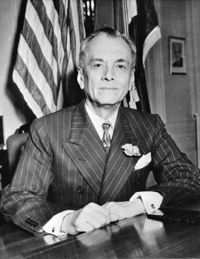
In 1935 Quezon won the Philippine's first national presidential election under the banner of the Nacionalista Party. He obtained nearly 68% of the vote against his two main rivals, Emilio Aguinaldo and Bishop Gregorio Aglipay. Quezon was inaugurated in November 1935. He is recognized as the second President of the Philippines. However, in January 2008, Congressman Rodolfo Valencia of Oriental Mindoro filed a bill seeking instead to declare General Miguel Malvar as the second Philippine President, having directly succeeded Aguinaldo in 1901.[35]
Quezon had originally been barred by the Philippine constitution from seeking re-election. However, in 1940, constitutional amendments were ratified allowing him to seek re-election for a fresh term ending in 1943. In the 1941 presidential elections, Quezon was re-elected over former Senator Juan Sumulong with nearly 82% of the vote.
In a notable humanitarian act, Quezon, in cooperation with United States High Commissioner Paul V. McNutt, facilitated the entry into the Philippines of Jewish refugees fleeing fascist regimes in Europe. Quezon was also instrumental in promoting a project to resettle the refugees in Mindanao.
Quezon suffered from tuberculosis and spent his last years in a "cure cottage" in Saranac Lake, New York, where he died on August 1, 1944. He was initially buried in Arlington National Cemetery. His body was later carried by the USS Princeton and re-interred in Manila at the Manila North Cemetery before being moved to Quezon City within the monument at the Quezon Memorial Circle.
Osmeña Administration (1944-1946)
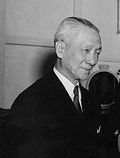
Osmeña became president of the Commonwealth on Quezon's death in 1944. He returned to the Philippines the same year with General Douglas MacArthur and the liberation forces. After the war, Osmeña restored the Commonwealth government and the various executive departments. He continued the fight for Philippine independence.
For the presidential election of 1946, Osmeña refused to campaign, saying that the Filipino people knew of his record of 40 years of honest and faithful service. Nevertheless, he was defeated by Manuel Roxas, who won 54 percent of the vote and became the first president of the independent Republic of the Philippines.
Roxas Administration (May 28, 1946-July 4, 1946)
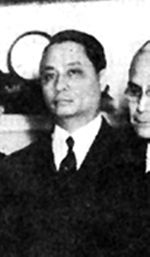
Roxas served as the President of the Commonwealth of the Philippines in a brief period, from his subsequent election on May 28, 1946 to July 4, 1946, the scheduled date of the proclamation of Philippine Independence. Roxas prepared the groundwork for the advent of a free and independent Philippines, assisted by the Congress (reorganized May 25, 1946), with Senator Jose Avelino as the Senate President and Congressman Eugenio Perez as the House of Representatives Speaker. On June 3, 1946, Roxas appeared for the first time before the joint session of the Congress to deliver his first state of the nation address. Among other things, he told the members of the Congress the grave problems and difficulties the Philippines are set to face and reports of his special trip to the United States–the approval for independence.[36]
On June 21, he reappeared into another joint session of the Congress and urged the acceptance of two important laws passed by the Congress of the United States on April 30, 1946 to the Philippine lands. They are the Philippine Rehabilitation Act and the Philippine Trade Act.[37] Both recommendations were accepted by the Congress.
See also
- Political history of the Philippines
- Treaty of Manila (1946)
Notes
- ↑ 1.0 1.1 1.2 Timeline 1930 – 1939, St. Scholastica's College;
^ Gin Ooi 2004, p. 387;
^ Zaide 1994, p. 319;
^ Franklin D. Roosevelt (November 14, 1935), Proclamation 2148 on the Establishment of the Commonwealth of the Philippines, The American Presidency Project, University of California at Santa Barbara, http://www.presidency.ucsb.edu/ws/index.php?pid=14980 (specifying, "This Proclamation shall be effective upon its promulgation at Manila, Philippine Islands, on November 15, 1935, by the Secretary of War of the United States of America, who is hereby designated as my representative for that purpose.") - ↑ 2.0 2.1 A Decade of American Foreign Policy 1941-1949 Interim Meeting of Foreign Ministers, Moscow. Retrieved September 30, 2009.
- ↑ THE PHILIPPINE COMMONWEALTH. November 16, 1935, Saturday. The New York Times. Retrieved on October 1, 2009.
- ↑ 4.0 4.1 4.2 4.3 4.4 4.5 4.6 "Philippines, The period of U.S. influence". Encyclopædia Britannica Online. http://www.britannica.com/eb/article-23717/Philippines. Retrieved 2007-02-10.
- ↑ "Tydings-McDuffie Act". Encyclopædia Britannica Online. http://www.britannica.com/eb/article-9073977/Tydings-McDuffie-Act. Retrieved 2007-02-10.
- ↑ "Text of the Tydings-McDuffie Act". The ChanRobles Group. http://www.chanrobles.com/tydingsmcduffieact.htm. Retrieved 2007-02-10.
- ↑ "Jones Act". Encyclopædia Britannica Online. http://www.britannica.com/eb/article-9043951/Jones-Act. Retrieved 2007-02-10.
- ↑ Philippine Historical Association 2000 (Chapter 4)
- ↑ Aviation During World War II: countries involved in World War Two. Retrieved September 30, 2009.
- ↑ "Constitutions of the Philippines". The ChanRobles Group. http://www.chanrobles.com/philsupremelaw.htm. Retrieved 2007-02-10.
- ↑ "Text of the 1935 Constitution". The ChanRobles Group. http://www.chanrobles.com/1935constitutionofthephilippines.htm. Retrieved 2007-02-10.
- ↑ 12.0 12.1 Dolan 1991 "Commonwealth Politics, 1935-41"
- ↑ Agoncillo 2001
- ↑ Hayden 1942
- ↑ "The Yamashita Standard". PBS. http://www.pbs.org/wnet/justice/world_issues_yam.html. Retrieved 2007-02-12.
- ↑ 16.0 16.1 "Philippine History". DLSU-Manila. http://pinas.dlsu.edu.ph/history/history.html. Retrieved 2007-02-11.
- ↑ 17.0 17.1 17.2 17.3 "A History of Plebiscites in the Philippines". Arab News. http://arabnews.com/?page=7§ion=0&article=80107&d=8&m=11&y=2006. Retrieved 2007-02-12.
- ↑ "Hare-Hawes-Cutting-Act". Encyclopædia Britannica Online. http://www.britannica.com/eb/article-9039248/Hare-Hawes-Cutting-Act. Retrieved 2007-02-10.
- ↑ Agoncillo 1970, pp. 345-346
- ↑ Officially, the Philippine Independence Act; Public Law 73-127; approved on March 24, 1934.
- ↑ 1935 Constitution of the Republic of the Philippines
- ↑ Zaide 1994, pp. 317-318
- ↑ Agoncillo 1970, p. 390
- ↑ Agoncillo 1970, p. 392
- ↑ Lacsamana 1990, p. 168
- ↑ Agoncillo 1970, p. 415
- ↑ 27.0 27.1 27.2 27.3 Dolan 1991
- ↑ Weir
- ↑ Dolan 1991
- ↑ "Balitang Beterano: Facts about Philippine Independence". Philippine Headline News Online. http://www.newsflash.org/2004/02/tl/tl012375.htm. Retrieved 2007-02-11.
- ↑ "Philippine history - American Colony and Philippine Commonwealth (1901-1941)". Windows on Asia. Archived from the original on 2007-10-10. http://web.archive.org/web/20071010133830/http://www.asia.msu.edu/seasia/Philippines/History/hist_AmerColony.html. Retrieved 2007-02-11.
- ↑ Philippine Almanac 1986, p. 140
- ↑ 33.0 33.1 33.2 33.3 Philippine Almanac 1986, p. 338
- ↑ 34.0 34.1 "American Colony and Philippine Commonwealth (1901-1941)". Filipinas Heritage Library. http://www.filipinaslibrary.org.ph/history/. Retrieved 2007-02-12.
- ↑ According to Valencia, "General Malvar took over the revolutionary government after General Emilio Aguinaldo, first President of the Republic, was captured on March 23, 1901, and [was] exiled in Hong Kong by the American colonial government—since he was next in command.” Maricel Cruz (2008-01-02). "Lawmaker: History wrong on Gen. Malvar". http://www.manilatimes.net/national/2008/jan/02/yehey/top_stories/20080102top6.html. Retrieved 2008-05-02.
- ↑ Official Gazette (Manila, May 1946) vol. 42 no. 5, pp. 1151–1165
- ↑ Official Gazette, July 1946, vol. 42 no. 7, pp. 1625–1628
References
- Roces; Juan Luis Z. Luna (Jr.); Reynaldo Arcilla (1986), RR philippine almanac: book of facts 1986 edition, Ramon Roces y Pardo, http://books.google.com/books?id=TI9GHAAACAAJ
- Philippine Historical Association (2000), Philippine Legislature, 100 Years, Philippine Historical Association in cooperation with New Day Publishers, ISBN 9719224509, http://books.google.com/books?id=cROcGAAACAAJ
- Agoncillo, Teodoro (2001), The Fateful Years: Japan's Adventure in the Philippines 1941-1945, 1, Quezon City, Philippines: University of the Philippines Press, ISBN 9789715422741, http://books.google.com/books?id=JhdxAAAAMAAJ
- Agoncillo, Teodoro A.; Milagros Guerrero (1970), History of the Filipino People, Malaya Books, http://books.google.com/books?id=VTwMAAAAIAAJ&pgis=1, retrieved 2007-12-28
- Gin Ooi, Keat (2004), Southeast Asia: a historical encyclopedia, from Angkor Wat to East Timor, ABC-CLIO, ISBN 9781576077702, http://books.google.com/books?id=QKgraWbb7yoC
- Seekins, Donald M. (1991), "The Commonwealth", in Dolan, Ronald E., Philippines: A Country Study, Washington: GPO for the Library of Congress, http://countrystudies.us/philippines/20.htm, retrieved 2007-12-28
- Seekins, Donald M. (1991), "World War II", in Dolan, Ronald E., Philippines: A Country Study, Washington: GPO for the Library of Congress, http://countrystudies.us/philippines/21.htm, retrieved 2007-12-28
- Dolan, Ronald E., ed. (1991), "Economic Relations with the United States", Philippines: A Country Study, Washington: GPO for the Library of Congress, http://countrystudies.us/philippines/23.htm, retrieved 2007-12-28
- Hayden, Joseph Ralston (1942), The Philippines, a Study in National Development, Macmillan, http://books.google.com/books?id=yOUBAAAAMAAJ&pgis=1, retrieved 2007-12-28
- Lacsamana, Leodivico Cruz (1990), Philippine History and Government, Phoenix publishing House, ISBN 9710618946, http://books.google.com/books?id=Wb53AAAACAAJ, retrieved 2007-12-28
- Weir, Fraser, "American Colony and Philippine Commonwealth 1901 - 1941", A Centennial History of Philippine Independence, 1898-1998, http://www.ualberta.ca/~vmitchel/fw5.html, retrieved 2007-12-28
- Zaide, Sonia M. (1994), The Philippines: A Unique Nation, All-Nations Publishing Co., ISBN 971-642-071-4
External links
- The Present Government of the Philippines Book written by Maximo Kalaw detailing the functions of the different branches of the Philippine Commonwealth
- Parallel and Divergent Aspects of British Rule in the Raj, French Rule in Indochina, Dutch Rule in the Netherlands East Indies (Indonesia), and American Rule in the Philippines
- Philippines: Polity Style: 1897-2009
.svg.png)

